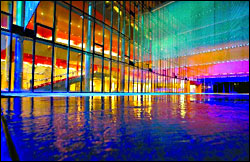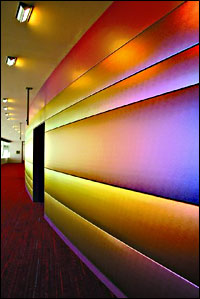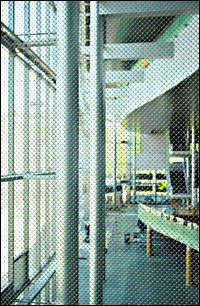 |
 |
 |
| HOME | McCaw Hall | Timelines | Events |
|
Sunday, June 22, 2003 By Melinda Bargreen
Now, one of the last and most expensive properties of the game has fallen into place: the second renaissance of the 1928 Seattle Civic Auditorium, which became the Opera House in 1962 and has now arisen as Marion Oliver McCaw Hall. When Seattle Art Museum's $58.5 million Olympic Sculpture Park is completed, almost $1 billion will have been spent on new and remodeled arts buildings since 1983, according to ArtsFund figures. This $127 million Opera House transformation also is the newest in a long series of developments at the Seattle Center, where so many of the region's performing-arts groups already reside. And it's the new home for Pacific Northwest Ballet and Seattle Opera, the last two of the "majors" to get their performance hall. That $127 million has bought a hall that's definitely not your old Opera House — one that has, in its rounded glass, lantern-like northwest corner, some faint echoes of the 1998 Benaroya Hall downtown. Not surprising, perhaps, in view of the fact that the architectural firm of LMN (Loschky, Marquardt and Nesholm, whose team of 30 designers is headed by project architect Mark Reddington) designed both buildings, with an eye to opening up each hall to passers-by outside. McCaw Hall provides much the old Opera House didn't. "This project offers a dramatic and engaging theatrical experience in the exterior spaces and the way it presents itself to the community. It's something that doesn't exist anywhere else in the world," Reddington says. "It makes the theatrical experience available to everyone; whether you walk or drive by, the hall will offer something about the art of theater outside to the community."
Interior more audience-friendly
When the hall opens June 28, arts buffs and critics from around the country will assemble with local audiences to assess the hall's design and acoustics. But for the heads of Seattle Opera and PNB, the primary tenants of McCaw Hall, the verdict is already in. "It's better than I expected, more beautiful, with wonderful colors," says PNB artistic co-director Francia Russell. "The facilities for the artists are great, but it will be even better for the audiences. They'll feel celebrated there. Because they will feel so much closer to the stage, the public will experience the dancers as real people, not distant figures. I think the feeling of intimacy between performers and audiences will captivate Seattle." Dramatic design, bold colors
As you approach McCaw Hall, it's almost impossible to recognize the old Opera House. A 17,800-square-foot public plaza, Kreielsheimer Promenade, serves as the main entrance, linking the Seattle Center with Mercer Street. It's paved with terrazzo tiles, and it also has outdoor seating areas, landscaping and water features (by landscape architect Kathryn Gustafson).
Inside, the wide staircases and larger lobby spaces on each level will allow patrons to mingle, to look up and down at the different levels. Patrons will experience a blast of color as they look around, from the wine-colored carpeting to walls in eye-opening shades of red, orange and purple. Those colors were chosen by artist Deborah Sussman, together with Seattle Center director Virginia Anderson, Seattle Opera general director Speight Jenkins and PNB artistic co-director Kent Stowell. "We wouldn't buy those colors until they were painted on huge flats. We've all built houses, and we know a paint chip doesn't say much. We looked at huge painted surfaces, about 20 by 25 feet, before we said 'yes,'" Jenkins says. "I wanted vibrant colors in an opera house, and to avoid the earth tones you find so much in the Northwest." Not a bad seat in the house
One of the big changes from the old Opera House, of which about 40 percent remains (in terms of underlying structure and the ceiling), is a drawing-in of the listeners: The balconies have moved forward, new side boxes and a sloping side gallery have brought in the side walls. This has transformed the vast, all-purpose interior of a hall originally built in 1928. Now it more closely resembles the European model of an opera/ballet theater, with a more intimate ambience in the auditorium and more gracious public spaces to see and be seen in. All this without the usual drawbacks of those great old houses — tiny, cramped seats with no legroom, from an era in which people were much smaller than they are today. "One of my greatest joys," says Jenkins, "was when they first opened the boxes (during construction). I went down to the lowest box, which is usually the 'company box'; I've sat in many of these around the world. In many European cities, this box sees at best half to two-thirds of the stage. I almost flipped out when I saw seven-eighths of the stage was visible." The seating capacity of the main auditorium has shrunk by around 200 seats, down to 2,900. Of those seats, 1,018 are on the orchestra level, 242 in the gallery, 220 in the dress circle, 508 on the first tier, 74 in the first tier boxes, 786 on the second tier and 52 in the second tier boxes. Some space is allotted to standing room; at last, the companies will be able to boast "Standing room only" on sold-out nights. Behind-the-scenes upgrades
A 400-seat auditorium on the north side of the building is another major new amenity. It's the perfect size for pre-event lectures, post-event discussions, speeches and meetings of all kinds. It is not designed specifically as a performance space, but recitals and small concerts could take place there (the acoustics have been designed by the Seattle firm of Michael Yantis and Associates). Some of the most exciting improvements will be missed by most opera and ballet fans: the backstage enhancements. Behind the new, taller proscenium (stage opening) lies a vast backstage with a loading dock on the east side, state-of-the art lighting and audio/video consoles, rigging system, scenery elevator, a 4,000-square-foot rehearsal hall, and a huge array of rooms (for dressing, makeup, changing, lounging, therapy, crew, wardrobe, props, paint and lots more). As Northwest residents pour into the new hall this coming week (see schedule of events), there's a huge upswing in interest in McCaw Hall. Both Seattle Opera and PNB report a surge in ticket sales for 2003-04; if patterns established elsewhere prevail, that surge should hold for at least a couple of years. The real challenge will be keeping, and building on, the audiences — a task that lies in the hands of the resident organizations. Melinda Bargreen: mbargreen@seattletimes.com
|
|
|||||||||||||||||||||||||||
seattletimes.com home
Home delivery
| Contact us
| Search archive
| Site map
| Low-graphic
NWclassifieds
| NWsource
| Advertising info
| The Seattle Times Company


